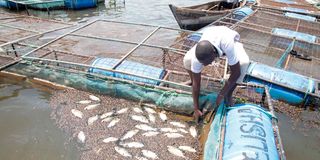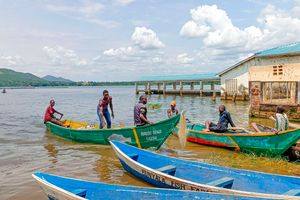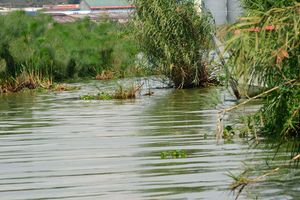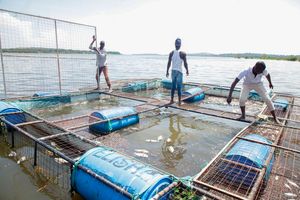
A fisherman collects dead fish from fish cages in Lake Victoria on October 20, 2022.
A state agency investigating mass fish deaths in Lake Victoria has attributed the crisis to oil spills, decomposing aquatic matter and the discharge of untreated waste into the water.
The research was by the Freshwater Directorate of the Kenya Marine and Fisheries Research Institute (KMFRI) and the Kisumu County Fisheries Department.
Kisumu City residents woke up to find floating tilapia and Nile perch near beaches on January 28.
In 2022, hundreds of fishermen incurred losses estimated at Sh1 billion following mass fish deaths.
The phenomenon was also witnessed in 2023, with cage fish farmers suffering losses.
Preliminary observations in the affected areas included foul smell, a thick layer of algae on the water and bubbling.
“An oil layer was also present, which likely prevented oxygen from dissolving in the water and was suspected to coat the gills of fish, eventually suffocating them,” reads the February 3 report by KMFRI Freshwater Systems Research Director Christopher Aura.
The findings were a result of site observations and interviews, measurement of physico-chemical parameters and analyses of collected water and fish samples.
According to the study, most physico-chemical parameters were not within the globally recommended standards and, therefore, not suitable for fish and other aquatic life survival.
“Dissolved oxygen levels were very low at Kisat Rivermouth, Fisheries Pier and off Coca-Cola stations. There was decreased depth, indicating hypoxic conditions which are related to nutrient decay and overloading. That can cause fish deaths,” Dr Aura said.
The presence of high ammonium levels explained the low dissolved oxygen levels experienced in the stations due to microbial decomposition of organic matter, indicating possible wastewater contamination.
Very high total nitrogen and total phosphorus concentrations recorded in all the stations indicated nutrient pollution from industrial effluent, wastewater discharge and runoff from upstream.
According to Dr Aura, the layer of oil observed stretching from the Kenya Pipeline Company Kisumu depot towards Coca-Cola and the pier likely worsened the low oxygen levels early that morning.
“The oil acted as a barrier, impairing gas exchange by preventing oxygen from dissolving in the water. Additionally, the oil could coat gills, hindering respiration and compounding the hypoxic stress caused by algal blooms,” Dr Aura said.
The findings put the companies operating near the lake on the spot.
National Environment Management Authority (Nema) Kisumu County Director, Leonard Ofula, describes the mass fish deaths as complex.
He, however, says it could be avoided if companies handle waste as prescribed in law, adding that human activities that endanger aquatic life need to be discouraged.
Mr Ofula says authorities are yet to establish the source of the oil spillage.
Some years back, Nema ordered the withdrawal of effluent discharge licences for Maseno University, Kodiaga Prison and Kisumu Water and Sanitation Company (Kiwasco) for polluting the lake and Rivers Nyando and Kisat.
The agency says the institutions now treat their waste.
“We have engaged companies like Coca-Cola and Kenya Breweries Ltd who have put up systems that ensure wastewater is treated and channelled to Kiwasco. Coca-Cola, for instance, uses the lake water for production, meaning it cannot contaminate the same water it depends on,” Mr Ofula said.
“This does not mean we’ve dropped our guard. We regularly call meetings with these companies and demand analyses of effluent discharged to Kiwasco.”
He, however, adds that settlements near the lake are also guilty of pollution.
“There are septic tanks and pit latrines around. There is need to expand the town’s sewerage system to handle such since Kiwasco only covers about 20 per cent,” Mr Ofula said.
He advises the devolved government to conserve soil and water, adding that it would lower the nutrient load in the lake.
“Lake Victoria has high nutrient load because fertiliser washed from farms ends up in rivers, which finds its way in the lake in the form of phosphates and nitrates,” Mr Ofula said.
Neighbouring counties – Vihiga, Nandi, Kakamega, Busia, Homa Bay, Kericho and Kisii – are catchment areas whose main activity is farming.
The KMFRI research recommends random visits by relevant agencies to inspect points of sources of pollution.
It also proposes the enforcement of regulations to reduce industrial and domestic pollution.
“Companies should periodically present and implement control measures put in place to minimise oil spill and untreated sewage discharges,” Dr Aura said.
The researchers call for improved efforts in the development of wastewater treatment facilities.
They say wetland reclamation is necessary to filter runoff before it gets to the lake.
Working or living in Kisumu has been a nightmare for a while because of the stench emanating from the lake.
Experts attribute the smell to dead plants like water hyacinth, hippo grass and reeds accumulating in the deep of the lake where decomposition takes place, thus releasing ammonia and hydrogen sulphide gases.
In such situations, only catfish, lungfish and other “hardy” marine animals survive.












